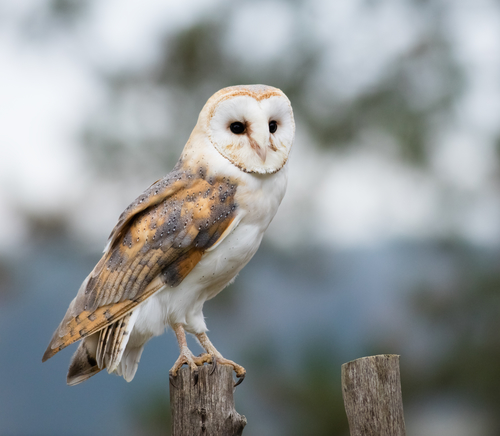
Owls are birds of prey, that are mostly nocturnal (active at night) comprising the order Strigiformes. The order is divided into two families: Tytonidae or barn owls and related species, and Strigidae or Typical Owls. Owls are best known for their ability to fly silently in the air, when striking on prey. This feature is important, since most owls hunt during the night, and there is less noise in the environment. Any noise made by the owl could easily warn the potential prey.
There are many differences between the two families of owls, such as their size, habitat, prey, and the way they hunt.
Appearance
Typical owls tend to have large heads, stocky body, round faces and cryptic, mottled brown and white plumage. They vary greatly in size. As with most birds of prey, most typical owl species have females larger than the male. They don’t show sexual dimorphism and both sexes have the same plumage. Barn owls are usually smaller in size as compared to typical owls. They are medium sized owls and are pale colored, and have distinctive, heart shaped faces.
Habitat
Owls are adaptive animals and are found everywhere except Antarctica. Typical owls are usually found in woodlands. Barn owl habitats include agricultural areas, deserts, grasslands, and forests. Barn owls sometimes nest in barns on agricultural lands. Hence how they got the name, barn owls. Barn owls roost during the day and use buildings like barns and church towers for this purpose.
Behavior
Most typical owls are nocturnal and hunt during the night. They have excellent hearing and eyesight, which help them in finding prey. Most owls are solitary, but few species live in groups. Some species of owls are also migratory. Barn owls are also nocturnal and leave for hunting at night. They are monogamous and mate for life.
Hunting
Most typical owls, and barn owls are both nocturnal and hunt at night, but the way they hunt is different. Their prey includes small mammals, reptiles, insects, birds, and sometimes fish. Typical owls usually perch in a tree and wait for the right moment. It uses its excellent hearing and sharp eyesight for finding potential prey. Once they spot the prey, they become airborne and grasp their prey. They are also known to catch and eat fish. Barn owls fly low in the open spaces, marshes and agricultural lands. They are even known to cover many miles in a night, in search of prey. They usually find their prey using their excellent sense of hearing.
Reproduction
Most typical owls are solitary, nocturnal birds and spend most of the day roosting. They are usually monogamous and mate for life. As the breeding season approaches, the lonely owls reunite with their mates at their nesting sites. The female may lay up to 13 eggs. The incubation lasts for approximately 30 days. The female and male both take turns, caring to take care of the nest.
Barn owls don’t have a specific breeding season. Most barn owls start breeding, when there is an increase in the rodent population. They are also monogamous and mate for life. They often raise two broods in a good year.
